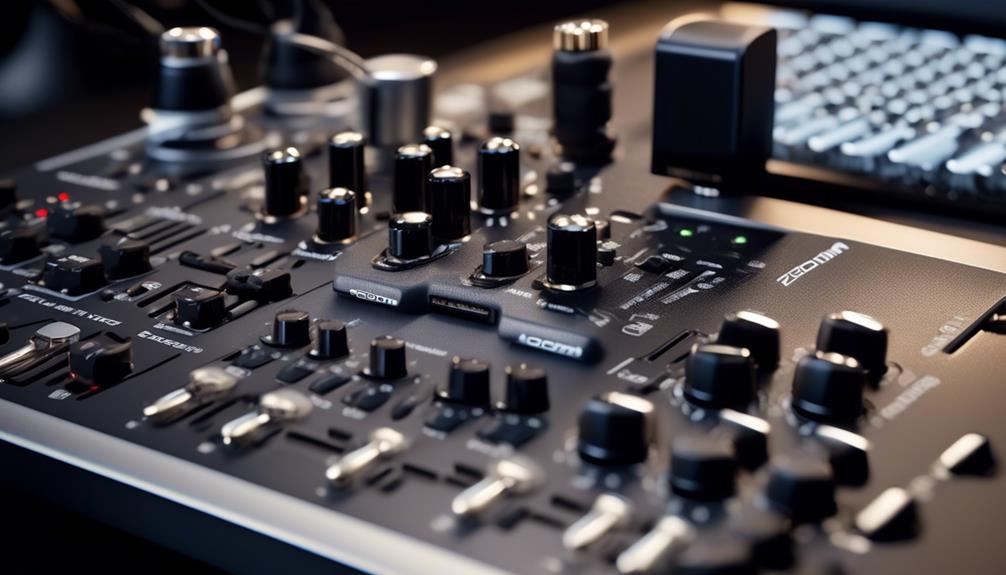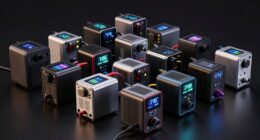We’ve all faced the challenge of trying to fit a square peg into a round hole, and utilizing the Zoom F8 as an audio interface can sometimes give off that same vibe.
There's a lot of buzz surrounding this topic, with some claiming success and others hitting roadblocks.
But what's the real deal? Can this versatile piece of equipment truly pull double duty as an audio interface?
Well, let's just say there's more to the story than meets the eye, and we might uncover some surprising insights along the way.
Key Takeaways
- The Zoom F8 can function as an audio interface with Logic X, allowing for seamless recording capabilities.
- Users may need to manually transfer and align audio tracks from the F8's memory card to Logic X.
- Some users have reported issues with the channel phantom appearing to be switched off, requiring troubleshooting.
- The Zoom F8 offers versatile connectivity options and can be used as a USB audio interface with the same drivers as the F4 and H6, providing increased functionality without extra equipment.
Zoom F8 Audio Interface Compatibility
When using the Zoom F8 as an audio interface, compatibility with various digital audio workstations (DAWs) is a crucial consideration for seamless integration and efficient music recording.
The Zoom F8 has been reported to work seamlessly as an audio interface with Logic X, providing users with a positive experience. However, some users have encountered difficulties when using the F8 as an interface with Logic, requiring them to manually drag each audio track from the card onto Logic and align them, which may demand additional effort. This indicates that while the compatibility with Logic X is generally favorable, there are certain operational intricacies that users need to be mindful of.
Moreover, users have expressed interest in effectively utilizing the F8 as an interface for music recording in various locations. There have also been inquiries regarding monitoring tracks back from a DAW through the F8 while in interface mode. Additionally, one user reported an issue with the F8 where the channel phantom appeared to be switched off when using it as an audio interface, suggesting potential compatibility challenges that may need to be addressed.
Therefore, understanding the specific compatibility requirements and potential challenges when using the Zoom F8 as an audio interface is essential for achieving optimal results.
Connectivity Options for Zoom F8

Having explored the compatibility considerations and potential challenges of using the Zoom F8 as an audio interface, we now turn our attention to the connectivity options available for the device.
The Zoom F8, when used as an audio interface, offers versatile connectivity options. It allows for streaming or recording with a DAW and defaults to a sample rate of 44.1 kHz and a bit depth of 16 in USB interface mode. While there's no menu option to change to 48/24, the device can be configured for higher fidelity.
Additionally, the Zoom F8 can be used as a USB audio interface with the same drivers as the F4 and H6, providing a cost-effective solution for using multiple microphones.
The connectivity options for the Zoom F8 as an audio interface also include the ability to control the sample rate in USB controller mode using the Zoom ASIO driver. This driver adjusts the sample rate according to software settings, and the Windows 10 menu can be used to edit the driver, ensuring successful implementation of the desired sample rate.
Moreover, utilizing the Zoom F8 as a USB audio interface allows for increased functionality without the need for extra equipment, offering flexibility in choosing the number of available channels. Accessing additional resources and community support can further enhance the understanding and utilization of the Zoom F8 as an audio interface.
Benefits of Using Zoom F8 as Audio Interface
The Zoom F8 operates seamlessly as an audio interface with Logic X, providing reliable and efficient recording capabilities. Its compatibility with Logic X allows for effortless integration into existing recording setups, making it an ideal choice for professionals seeking high-quality audio recording.
The F8's superior recording quality onto cards has garnered appreciation from users, positioning it as a top contender for professional audio setups. Notably, its high-quality preamps and DAC deliver exceptional performance, surpassing user expectations and outperforming other interfaces in its price range.
The F8's versatility shines through in its convenience as a music interface for recording in various locations. Its user-friendly interface and easy monitoring from a computer in interface mode enhance the recording experience. Furthermore, the F8 offers a cost-effective solution for using multiple microphones, making it a valuable tool for audio recording.
Its compatibility with various systems further solidifies its status as a versatile and reliable audio interface. In conclusion, the Zoom F8 stands out as a dependable, high-performance audio interface that exceeds expectations and offers significant benefits for professional audio recording setups.
Configuring Zoom F8 for Computer Use

Zoom F8's seamless compatibility with certain DAWs, such as Logic X, allows for its configuration as an audio interface, providing efficient functionality for streaming and recording.
When configuring the Zoom F8 for computer use, there are several essential steps to consider:
- Selecting Audio Interface Mode: Users need to turn on the computer, open the project, and select the audio interface mode in the F8's settings to enable its functionality as an audio interface.
- Utilizing High-Quality Preamps and DAC: The F8's high-quality preamps and DAC make it an excellent choice for recording onto cards, offering superior performance compared to other interfaces.
- Flexibility for Recording in Various Locations: Users can easily set up the F8 as a music interface for recording in various locations and monitor tracks back from a DAW through the F8 while using it as an interface.
Troubleshooting Zoom F8 as Audio Interface
When troubleshooting the use of Zoom F8 as an audio interface, it's crucial to address potential issues with integration and functionality to ensure seamless operation.
Some users have encountered challenges with the phantom channel appearing to be switched off and confusion regarding different statuses. To troubleshoot these issues, ensure that the F8 is set to the proper sample rate and that all channels are correctly linked to the DAW.
Additionally, when using the F8 as a field recorder and then switching to its audio interface functionality, it's important to power it with the AC adapter to ensure stable performance.
Users interested in monitoring tracks back from a DAW should check the routing settings and ensure that the F8 is properly recognized as the audio interface in their DAW software.
When disconnecting the F8 from the computer, it's crucial to follow the proper steps to ensure that it can be used again as a standalone recorder.
Troubleshooting the Zoom F8 as an audio interface requires attention to detail and thorough understanding of its integration with the computer system.
Frequently Asked Questions
Can I Use Zoom Recorder as Audio Interface?
Using the Zoom F8 as an audio interface enhances our recording setup.
It allows seamless integration with various mixers, providing flexibility in our setup.
The sound quality is top-notch, with its preamps and DAC delivering exceptional performance.
However, we've encountered minor issues with phantom channel switching.
Despite this, the F8 remains a valuable tool for our audio interface needs.
Can You Use Zoom R8 as Audio Interface?
Yes, the Zoom F8 can be used as an audio interface, enabling a versatile recording setup. This studio equipment offers exceptional sound quality and flexibility for various recording environments. With high-quality preamps and DAC, it surpasses expectations.
However, users have reported issues with phantom channel switching and confusion in different statuses. Despite these challenges, the F8's performance rivals the SSL+, enhancing microphone sound quality and providing reliability for professional recording.
What Does F8 Do in Zoom?
The Zoom F8 is a versatile audio recording device designed for professional audio production. It offers advanced recording capabilities that make it ideal for capturing high-quality audio. The F8 features multiple XLR/TRS inputs, timecode input/output, and USB audio interface mode, providing a wide range of connectivity options. This allows for seamless integration with computers and other audio equipment. With the ability to record onto cards and connect to computers, the F8 offers flexibility for various recording scenarios. Its precise controls and intuitive interface make it easy to use, making it a powerful tool for capturing audio in any environment.
Is Zoom F6 an Audio Interface?
Yes, the Zoom F8 can function as an audio interface, enhancing our audio recording capabilities. It seamlessly integrates with various external devices, offering versatile connectivity options.
Users can rely on its robust recording equipment for professional audio production. However, we must ensure compatibility with our specific software and address potential challenges, such as phantom channel issues.
But overall, the Zoom F8 serves as a valuable asset for our audio interface needs.
Conclusion
In conclusion, the Zoom F8 can function as an audio interface, offering connectivity options and benefits for recording.
While some users have encountered challenges, the F8's high-quality preamps and DAC make it a favorable choice for many.
With proper configuration and troubleshooting, the F8 can be effectively used as an interface, providing a seamless and efficient recording experience.










